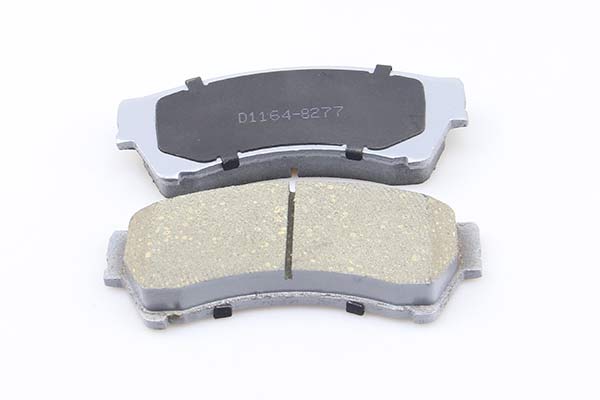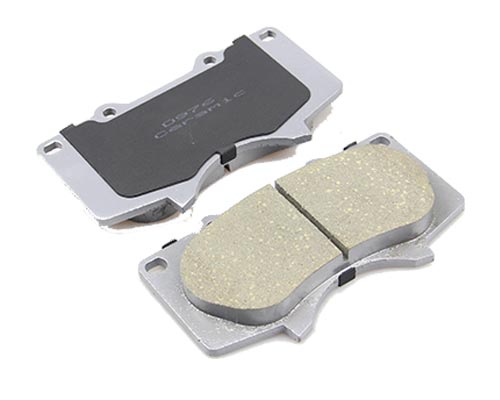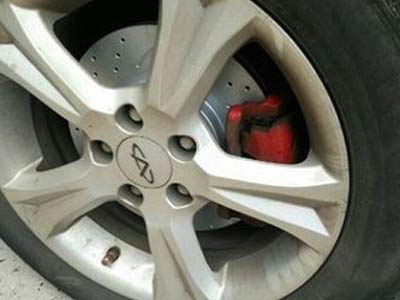
What is a Ceramic Brake Pad?
A ceramic brake pad is a type of brake pad made from a mixture of ceramic fibers, non-ferrous filler materials, adhesives, and other composite materials.
We know that brake pads can generate high temperatures on the friction surface during high-speed and forceful braking, reaching temperatures of 800 to 900 degrees Celsius, and sometimes even higher. At these high temperatures, the surface of the brake pad undergoes reactions similar to metal-ceramic sintering.
Compared to semi-metallic brake pads, they have a significantly lower probability of noise and are very quiet. Additionally, they produce less dust during wear, making ceramic brake pads more suitable for comfort driving, luxury vehicles, and high-speed applications.

Are Ceramic Brake Pads Better?
Due to their cost, materials, performance, and usage in luxury vehicle brands, ceramic brake pads are often considered the top choice for brake pad materials. However, as Ketulla, a manufacturer specializing in the brake pad industry for 24 years, we emphasize that the choice of brake pad material should depend on our specific needs. The guiding principle should be to choose the right material, as expensive brake pad materials may not always be the best option for you.
Here are some pros and cons of ceramic brake pads to ensure you recommend them for the right applications:
Pros:
- Quieter Operation:Ceramic brake pads have a softer feel, and the absence of metallic fibers reduces the likelihood of noise and squeaking compared to other formulations. However, we cannot guarantee 100% silence, as there are many causes of noise.
- Less Dust:The primary material of ceramic brake pads is ceramic fiber. During braking, the friction between the brake pad and brake disc generates high temperatures, carbonizing the surface. Because ceramic fibers do not generate static electricity, dust does not adhere to the brake disc, keeping its surface cleaner than pads made from other materials.
- Longer Lifespan:Ceramic brake pads are often used in luxury vehicles, which typically do not involve aggressive driving behaviors. The wear resistance of ceramic fiber materials also contributes to a longer lifespan for ceramic brake pads.
- Consistent Performance:The unique materials used in ceramic brake pads, along with their excellent heat conductivity, ensure they maintain outstanding braking performance across a wide range of temperatures and conditions.
- Eco-Friendly Brake Pads:Currently, regulations prohibit the use of brass in ceramic brake pads due to environmental concerns, making ceramic brake pads more eco-friendly and compliant with environmental standards.
Cons:
- Higher Cost:Ceramic brake pads can be more expensive upfront compared to organic or semi-metallic options. The unique structure of ceramic materials typically results in a higher price than other formulations. However, Ketulla strives to keep costs manageable, with our prices generally being about 15% higher than standard brake pads, but with superior performance.
- Less Performance in Extreme Conditions:While they perform well under normal conditions, ceramic brake pads may not deliver the same level of performance in extreme cold, such as in sports cars or heavy-duty trucks.


How Can I Know if My Brake Pads are Ceramic?
For users less familiar with brake pads, it may be challenging to identify if their brake pads are made of ceramic friction material. Although different manufacturers may use varying formulations reflected in color differences, all ceramic brake pads share some common characteristics. Here are six methods to help you determine if your brake pads are ceramic:
-
Color Difference: Some brake pads may appear light yellow or “ash gray.” Look closely for metallic fibers; ceramic brake pads will not have any, while semi-metallic and low-metal pads will typically show darker gray colors.
-
Touch Test: When you run your finger over the surface of ceramic brake pads, it should not leave any black or other colored residue (except for dust). In contrast, metallic brake pads will leave a black residue due to the presence of metallic particles.
-
Rust: Since ceramic brake pads do not contain metallic fibers, they will not rust. In contrast, semi-metallic and low-metal pads can oxidize over time, leading to rust formation.
-
Installation Use: After installation, ceramic brake pads produce very little dust, with any residue on the brake disc being light gray or white. If the residue is dark gray and there are significant friction marks, it is likely that the pads are not made of ceramic material.
-
Purchase from Professional Factories: The market has many low-quality ceramic brake pads labeled as “ceramic.” These may use inferior materials and immature formulations, leading to quality issues such as severe noise, poor braking performance, detachment of friction material, installation difficulties due to size discrepancies, and inadequate after-sales service.
Conclusion
Using the methods outlined above to identify ceramic brake pads can help prevent being misled during your purchase, avoiding unnecessary losses. As a manufacturer with 24 years of experience,
Ketullabrakes maintains mature formulations and strict quality control, adhering to the ECE R90 quality standard. We ensure that every batch undergoes rigorous testing, providing test data along with orders. With 2,351 models of brake pads, we cover vehicles from globally recognized brands and update new models monthly to meet customer needs promptly.
Ketullabrakes sincerely hopes to collaborate with global buyers to ensure driving safety together.
Comments on “What is a Ceramic Brake Pad?”